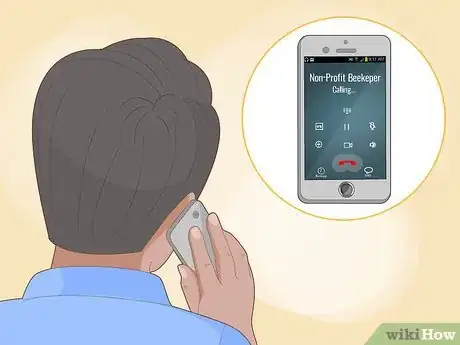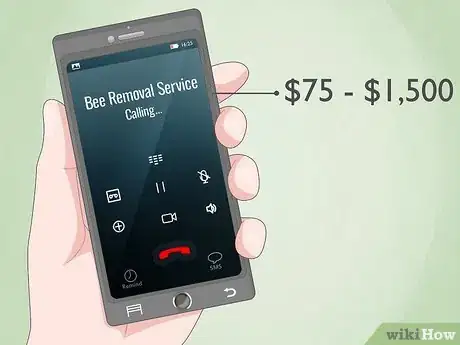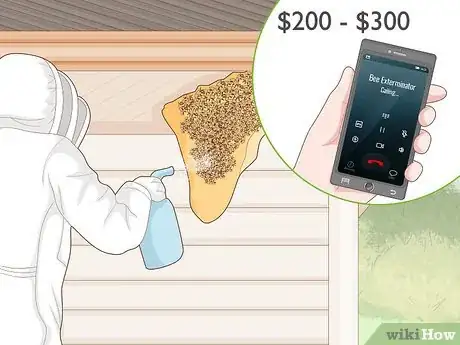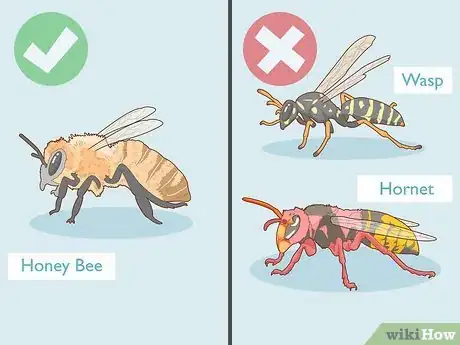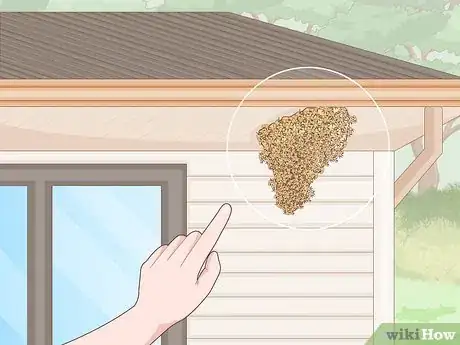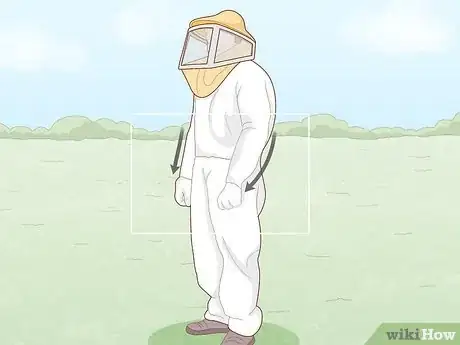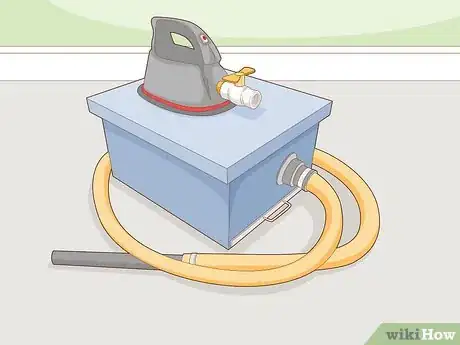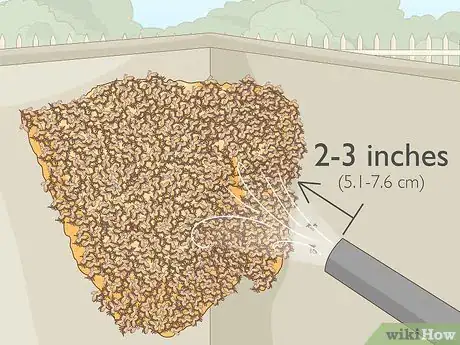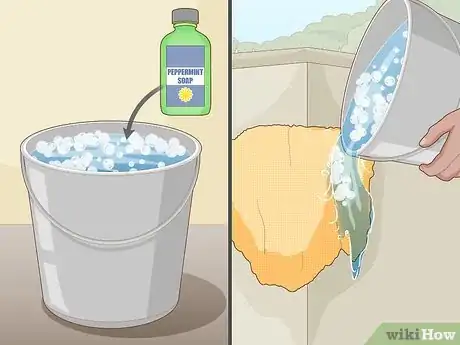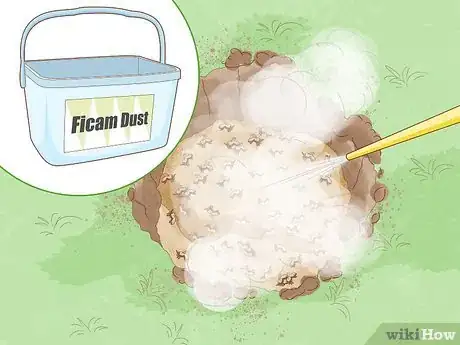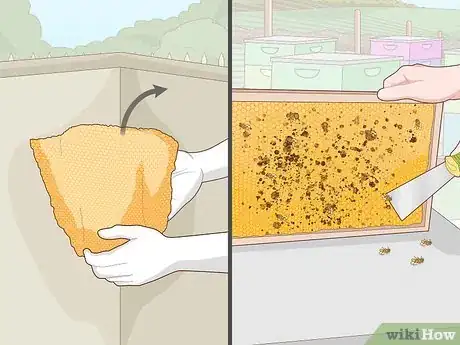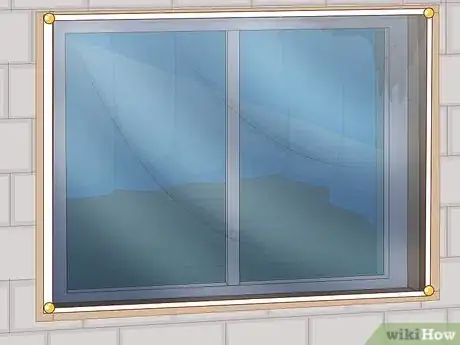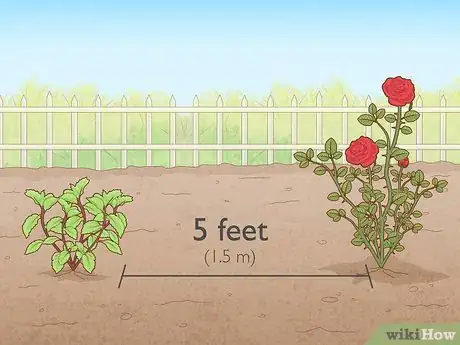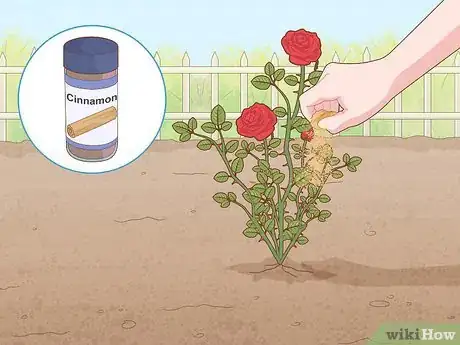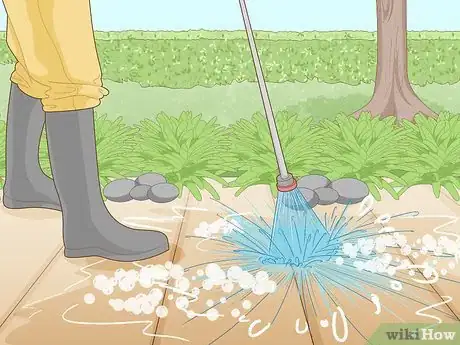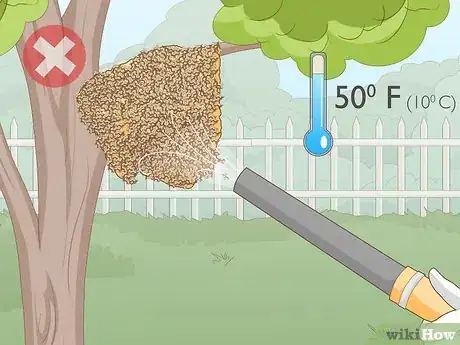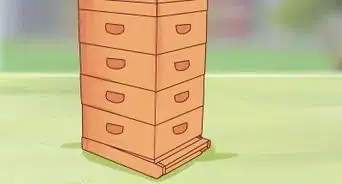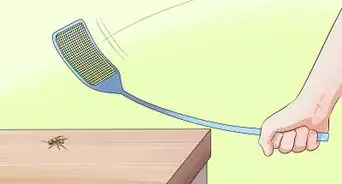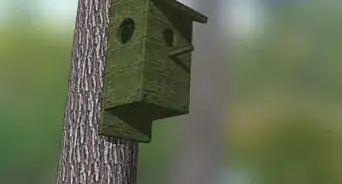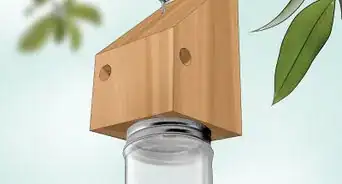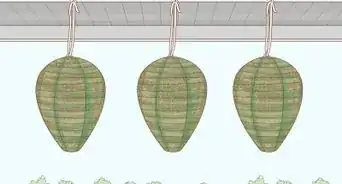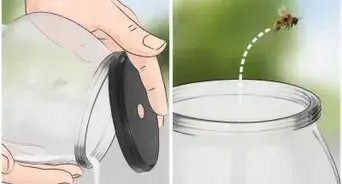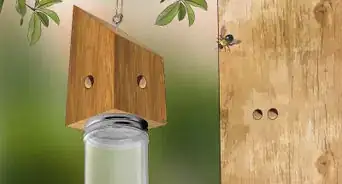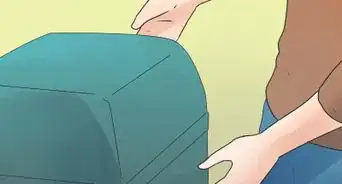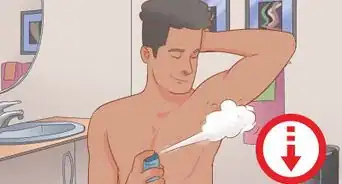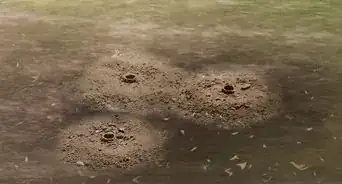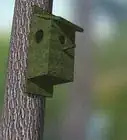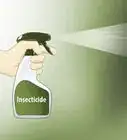This article was co-authored by Scott McCombe and by wikiHow staff writer, Eric McClure. Scott McCombe is the CEO of Summit Environmental Solutions (SES), a family-owned local pest solutions, animal control, and home insulation company based in Northern Virginia. Founded in 1991, SES has an A+ rating with the Better Business Bureau and has been awarded “Top Rated Professional,” and “Elite Service Award" by HomeAdvisor.
There are 10 references cited in this article, which can be found at the bottom of the page.
wikiHow marks an article as reader-approved once it receives enough positive feedback. In this case, several readers have written to tell us that this article was helpful to them, earning it our reader-approved status.
This article has been viewed 686,314 times.
Before you take any steps to remove bees, recognize that they are an incredibly important part of our environment. If there are simply a few bees frequenting your garden, the best way to handle them is to leave them alone. Unfortunately, if bees set up a hive in your garden or on your home, it’s understandable that you want them gone. Since bee removal requires a wide array of skills and knowledge about bee behavior, your best bet is to enlist the help of a local beekeeper, bee rescue, or exterminator. If you don’t have a hive nearby but you’re still being overwhelmed by bees, there are plenty of steps that you can take to deter the bees from hanging out in your yard or garden.
Steps
Hiring Help
-
1Contact a local beekeeper or nonprofit group first. Go online and search for beekeepers in your area. Call each beekeeper to see if they are interested in the hive, even if they don’t mention picking them up on their website. Beekeepers are experienced in safely removing bees without killing them and will happily relocate them. There are also nonprofit bee removal services that keep bees from becoming endangered in high-risk areas where their pollination skills are especially important.[1]
- You normally won’t need to pay a beekeeper to remove a hive. If you do, the fee won’t be particularly high, although it depends on where you live.
Tip: This is the absolute best way to have bees removed. Beekeepers won’t harm the bugs and will relocate them to a safe environment.
-
2Reach out to a bee removal service if you can’t find a local beekeeper. If there are no beekeepers or nonprofit groups in your area, call a bee removal service. You will have to pay to have the bees removed, but a bee removal service will remove the bees safely and thoroughly. Bee removal experts often sell or give away their hives and will not kill the bees unless absolutely necessary.[2]
- If the hive is easily accessed and the swarm isn’t particularly big, bee removal will cost $75-200. If drywall needs to be removed or the hive is in a tricky location, like a roof, it may cost up to $1,500.
Advertisement -
3Contact an exterminator if the hive can’t be removed.[3] If removing the bees is not an option because the colony is inaccessible, contact a local exterminator. This is the worst option, since bees are good for the environment and the chemicals in commercial bee pesticides can damage a home, but you can certainly hire an exterminator to kill the bees if it’s the only way to have them removed.[4]
- An exterminator will cost roughly $200-300, but a new colony is more likely to return if the exterminator doesn’t remove the hive or handle it properly. Make sure that you hire an exterminator with experience removing bees.
- If a large number of bees die and their corpses are not removed, they will break down and leave a particularly funky odor behind that will take some time to get rid of.
Removing the Hive Yourself
-
1Identify bees by their fur and round bodies to rule out wasps and hornets. Before you take action, look at the bug carefully to see whether it’s actually a bee. You can identify bees by examining their appearance. Bees have hair and tend to be rounder, while wasps and hornets have smooth exteriors and tend to have pointer thoraxes. You should also inspect the nest if you see one. Honey bees build their nests out of wax, whereas other stinging insects tend to construct their nests out of wood fiber or mud.
- Between the beekeeper’s outfit, the tools you’ll need, and the vacuum, expect to spend $100-300 on a DIY removal. It might be cheaper to hire a professional, and it's definitely safer for both you and the bees.
- It's important to make sure that you’re not dealing with wasps or hornets. Bees are valuable pollinators and are not aggressive or dangerous (unless someone in your family has an allergy), so killing them should be avoided whenever possible. Many hornets and wasps are extremely aggressive, so do not get closer if you suspect it isn’t a bee.
EXPERT TIPScott McCombe is the CEO of Summit Environmental Solutions (SES), a family-owned local pest solutions, animal control, and home insulation company based in Northern Virginia. Founded in 1991, SES has an A+ rating with the Better Business Bureau and has been awarded “Top Rated Professional,” and “Elite Service Award" by HomeAdvisor.Pest Control Specialist
 Scott McCombe
Scott McCombe
Pest Control SpecialistDid You Know? There are a few behavioral traits that can help distinguish Africanized bees. They exhibit extreme defensive behavior in comparison to the relatively docile European honey bee. They also have smaller colonies, and their colony sites tend to be unusually exposed, such as being found in small tree cavities, discarded tires, meter boxes, overhangs, and tree limbs.
-
2Locate the hive by inspecting your exterior walls and nearby trees. If the bees are swarming over the side of your house and you don’t see them flying away as the swarm gets smaller, they’re likely flying into an opening in your exterior walls. If they’re swarming around your roof, check the chimney to see if the bees have a hive there. These bees generally require professional removal. If the hive is in the ground or a nearby tree, you may be able to remove it yourself.[5]
- Some species of bee burrow underground. Ground bees should be fairly easy to identify since you’ll have lots of bee-sized holes in your garden or yard.
- You can remove bees from a wall or hidden area on your own, but it’s a lot harder to do and can take quite some time. It’s best if you can rely on a professional to do this.
Warning: If you have an allergy to bees, do not get close to inspect them and do not attempt to extract them without professional help.
-
3Wear a beekeeper’s outfit or long sleeves and heavy clothes.[6] If you try to remove a hive and don’t wear a beekeeper’s outfit, you’re going to be stung. Either buy a beekeeper’s outfit, or make your own by wearing several layers of thick clothing, sewing a veil into a wide-brimmed hat, and taping the seams airtight to keep bees out.[7]
- This is generally not a good idea unless you have experience working with stinging insects or you have no other way to handle the problem. This process can be quite time-consuming and it may get kind of complicated depending on the size of the colony.
- A professional-grade beekeeper suit will cost $50-100. You typically can’t rent one of these, so you’ll need to purchase one at a gardening store or online.
-
4Buy or rent a bee vacuum to remove the hive. A bee vacuum is a large, low-powered vacuum with a housing unit that safely removes bees without killing them. You can buy one online, but you may be able to rent one from a local beekeeper or gardening store. This is really the only way to safely remove bees without killing them if you’re unexperienced in bee removal.[8]
- There is a way to remove a colony naturally using a wire cone and an empty box, but this process takes 3-4 months and requires an extensive knowledge of hive behavior. This is not a reasonable way to remove bees if you’ve not a professional beekeeper.
- You can use a regular vacuum for this so long as it’s the type with a bag. Clean the bag out thoroughly before doing this to ensure that the debris in the vacuum doesn’t kill the bees.
-
5Vacuum the bees up when they’re swarming. When bees are swarming, they will cover a single area in a thick, deep layer. This typically happens during the hottest hours of the day. Turn your vacuum on and start at the bottom of the swarm. Hold the hose 2–3 inches (5.1–7.6 cm) away from the swarm and slowly move the hose back and forth until you’ve sucked up all of the bees. Put an airtight cap on the vacuum after you’re done.[9]
- Get as many of the bees as possible. You’ll need to destroy the hive afterwards if there is one, so do your best to save as many bees as you can.
- Bees typically swarm when they’re looking for a colony, so there may not be a hive if they are swarming on a solid surface.
- If the bees are swarming on a branch, you can simply cut it off and transfer the bees somewhere else.
-
6Take the bees to a beekeeper or release them somewhere else. Ideally, the best way to get rid of your trapped bees is to give them to a local beekeeper. If you can’t do this, simply take your vacuum to a remote location in a forest and open the bag. It may take several hours for the bees to leave. If they aren’t leaving voluntarily, you may need to cut the bag open or simulate a forest fire using a smoker to get them to flee.[10]
- The bees should be able to survive in the bag for 2-3 days. The sooner you can get rid of them, the better.
-
7Destroy visible hives with peppermint soap and water. Fill a bucket halfway with water. Fill the rest of the bucket up with soap. Add a few peppermint leaves and mix the ingredients together to combine them. Pour the mixture directly over the bee hive to render it inactive and flush out the larvae. This will ensure that no other bees come back to use the hive while you’re handling the problem.[11]
- If the hive is in a hard to reach location or you’re worried about getting stung, use a sprayer to apply the peppermint soap.[12]
- If you’re dealing with ground bees, pour a little bit of the mixture into each hole in the garden.
- You can also use a 1:1 ratio of hot water and white vinegar if you prefer. Peppermint is a proven irritant to bees though, and will surely keep the bees from coming back.
-
8Pump ficam dust into an opening to destroy hidden hives. If the hive is in a wall, opening, or tree trunk, you cannot access the hive directly. The only recognized insecticide that can control bees in dwellings is ficam dust. Pick some up from a pest control company and spray the dust into the opening with a powder duster. While a small amount of ficam dust can control a hive, you’re better off just spraying an entire 1–2 lb (0.45–0.91 kg) container into an opening just to be safe.[13]
- With a trapped or hidden hive, you will not be able to remove it. The ficam dust will render the hive inactive and it will break down over time. Alternatively, you can hire a contractor to open up the wall or brickwork to access the hive, although this may cost $200-1,000 depending on what’s behind the wall.
Warning: Wear protective eyewear, thick gloves, and a dust mask or respirator while doing this. Ficam dust is dangerous if it’s absorbed in your skin, lungs, or eyes.
-
9Remove the honey, honeycombs, and dead bees. If the honeycombs are visible and easily accessed, use a putty knife to scrape the honeycombs off and break them off of the surface. If there are any dead bees in the surrounding area, pick them up and place them in the trash. Wash honey off of surfaces with dish soap and a sponge. You can use white vinegar if the honey is on a rougher surface and the soap isn’t doing the trick.[14]
- Removing the bees, honey, and hive will ensure that no other bees get the idea that this is a good place for setting up a colony.
-
10Cover the opening of the hive with window screening if necessary. If the hive was located on a wall or in a tree trunk, cover the affected area with window screening. Either glue or staple the screening over the surface so that the edges cannot be lifted up. The window screening will prevent other bees from getting into the opening.[15]
- You can fill the inside of the opening with expandable foam if you prefer, but the window screening should be more than enough to keep pests out if the hive has been dealt with.
Keeping Bees out of Your Garden
-
1Plant peppermint in your garden to repel bees. Bees tend to stay away from peppermint. Plant some peppermint seedlings in your garden in the spring. Place your peppermint plants at least 5 feet (1.5 m) from the flowers that seem to attract the bees. Any bees that wander into your garden will smell the peppermint and stay away from your plants.[16]
- There is some evidence that marigolds will work as well, although some species really enjoy pollinating marigolds.
-
2Sprinkle cinnamon over your plants every day for a week to deter bees. Cinnamon is also a great natural bee repellent. Once a day, sprinkle a liberal amount of cinnamon around the plants in your garden. The amount of cinnamon you use depends on the size of your garden, but you’ll probably go through at least 1 container a day for a standard-sized home. Do this for 1-2 weeks to let nearby bees know this isn’t a good area for pollination, and the bees will stop coming back to your garden.[17]
- You don’t need to work the cinnamon into the soil. It’s fine to simply let it rest on top of plants and dirt.
Warning: This may not work if it rains during the 1-2 weeks that you’re doing this. Wait for an extended period of dry weather to do this.
-
3Wash your ledges with soapy water and mint to keep bees from nesting. Get a ladder, bucket, and sponge. Fill the bucket halfway with water and add 1-2 squirts of dish soap. Then, sprinkle a handful of mint leaves into the water. Enlist a friend to hold the ladder for you. Wash the ledges of your roof with the minty-soap to keep bees away. If your roof is flat, pour the remaining soap and water on your roof and spread it around with a broom or large sponge.[18]
- This will keep bees from setting up a colony in your chimney, roof, or garden. The odor from the mint and soap will linger for a while, and the bees that seem to be frequenting your home will look for somewhere else to set up shop.
-
4Leave the bees alone if they aren’t a bother and there’s no hive. If you look thoroughly and can’t find a hive, it’s possible that the colony doesn’t live nearby. If this is the case, you can probably leave the bees alone since they’re only in your garden for the pollen. Bees are incredibly good for the environment, and if you don’t need to destroy or remove the hive, simply leave it be.[19]
- If you live in an area where the temperature gets below 50 °F (10 °C) during the winter months, the hive may leave on their own. You may be able to simply wait them out.
Expert Q&A
Did you know you can get premium answers for this article?
Unlock premium answers by supporting wikiHow
-
QuestionHow do I stop bees from coming into my house?
 Scott McCombeScott McCombe is the CEO of Summit Environmental Solutions (SES), a family-owned local pest solutions, animal control, and home insulation company based in Northern Virginia. Founded in 1991, SES has an A+ rating with the Better Business Bureau and has been awarded “Top Rated Professional,” and “Elite Service Award" by HomeAdvisor.
Scott McCombeScott McCombe is the CEO of Summit Environmental Solutions (SES), a family-owned local pest solutions, animal control, and home insulation company based in Northern Virginia. Founded in 1991, SES has an A+ rating with the Better Business Bureau and has been awarded “Top Rated Professional,” and “Elite Service Award" by HomeAdvisor.
Pest Control Specialist
Warnings
- Always wear a beekeeper’s outfit when getting close to a swarm or hive.⧼thumbs_response⧽
- Never get close to a hive if you’re allergic to bees. The closer you get to a hive, the more likely they are to sting you.⧼thumbs_response⧽
- Only remove a hive yourself if it’s something you have experience doing, or it’s not a particularly large hive.[20]⧼thumbs_response⧽
- Wear protective eyewear, a dust mask, and gloves when applying insecticides or abrasive chemicals.[21]⧼thumbs_response⧽
Things You’ll Need
Removing the Hive Yourself
- Beekeeper’s suit
- Protective eyewear
- Dust mask or respirator
- Gloves
- Vacuum
- Peppermint
- Soap
- Mint
- Ficam dust
- Powder sprayer
- Putty knife
- Sponge
- Water
- Bucket
- Soap
- White vinegar
Keeping Bees out of Your Garden
- Peppermint
- Mint
- Cinnamon
- Dish soap
- Sponge
- Water
- Ladder
References
- ↑ https://www.pollinator.org/learning-center/bee-rescuers
- ↑ https://youtu.be/YxTCqE-YWKg?t=61
- ↑ Scott McCombe. Pest Control Specialist. Expert Interview. 19 November 2019.
- ↑ http://ipm.ucanr.edu/PMG/PESTNOTES/pn74159.html
- ↑ http://ipm.ucanr.edu/PMG/PESTNOTES/pn74159.html
- ↑ Scott McCombe. Pest Control Specialist. Expert Interview. 19 November 2019.
- ↑ https://www.clemson.edu/extension/beekeepers/fact-sheets-publications/honey-bee-colony-removal.html
- ↑ https://youtu.be/RNrDHedxUe8?t=57
- ↑ https://youtu.be/RNrDHedxUe8?t=57
- ↑ http://ipm.ucanr.edu/PMG/PESTNOTES/pn74159.html
- ↑ http://www.netnewsledger.com/2018/02/16/naturally-repel-bees-keep-away/
- ↑ https://youtu.be/K-t5kbTyNWw?t=228
- ↑ https://entomology.ca.uky.edu/ef606
- ↑ https://www.clemson.edu/extension/beekeepers/fact-sheets-publications/honey-bee-colony-removal.html
- ↑ https://www.clemson.edu/extension/beekeepers/fact-sheets-publications/honey-bee-colony-removal.html
- ↑ http://www.netnewsledger.com/2018/02/16/naturally-repel-bees-keep-away/
- ↑ http://www.netnewsledger.com/2018/02/16/naturally-repel-bees-keep-away/
- ↑ http://www.netnewsledger.com/2018/02/16/naturally-repel-bees-keep-away/
- ↑ http://ipm.ucanr.edu/PMG/PESTNOTES/pn74159.html
- ↑ https://www.clemson.edu/extension/beekeepers/fact-sheets-publications/honey-bee-colony-removal.html
- ↑ https://www.americanpest.net/docs/msds/ficam-dust-label.pdf
About This Article
The best way to get rid of bees is to call a local beekeeper and have them remove them for you. They can usually keep the bees alive, thus protecting the endangered species. If the beekeeper cannot remove the nest, you can try to make a mixture of sugar, water, and dish soap to attract and drown the bees as they look for food. For a faster solution, spray the hive with a wasp-killing pesticide on 2 to 3 occasions. Keep reading to learn other ways you can get rid of bees in your garden.
